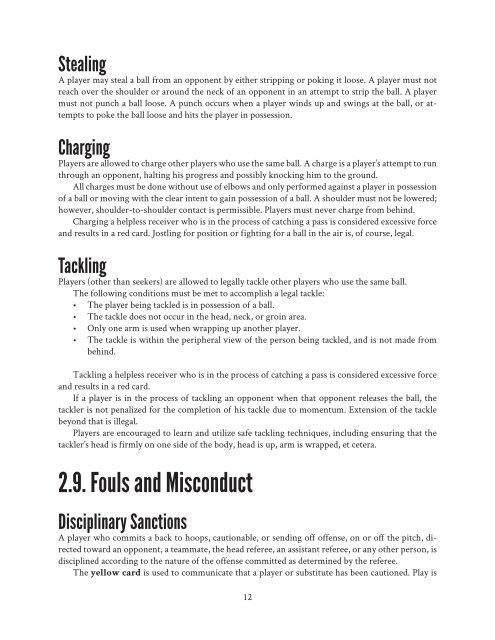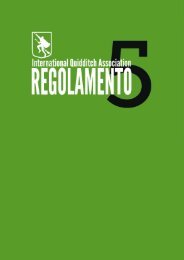IQA Rulebook - International Quidditch Association
IQA Rulebook - International Quidditch Association
IQA Rulebook - International Quidditch Association
Create successful ePaper yourself
Turn your PDF publications into a flip-book with our unique Google optimized e-Paper software.
Stealing<br />
A player may steal a ball from an opponent by either stripping or poking it loose. A player must not<br />
reach over the shoulder or around the neck of an opponent in an attempt to strip the ball. A player<br />
must not punch a ball loose. A punch occurs when a player winds up and swings at the ball, or attempts<br />
to poke the ball loose and hits the player in possession.<br />
Charging<br />
Players are allowed to charge other players who use the same ball. A charge is a player’s attempt to run<br />
through an opponent, halting his progress and possibly knocking him to the ground.<br />
All charges must be done without use of elbows and only performed against a player in possession<br />
of a ball or moving with the clear intent to gain possession of a ball. A shoulder must not be lowered;<br />
however, shoulder-to-shoulder contact is permissible. Players must never charge from behind.<br />
Charging a helpless receiver who is in the process of catching a pass is considered excessive force<br />
and results in a red card. Jostling for position or fighting for a ball in the air is, of course, legal.<br />
Tackling<br />
Players (other than seekers) are allowed to legally tackle other players who use the same ball.<br />
The following conditions must be met to accomplish a legal tackle:<br />
• The player being tackled is in possession of a ball.<br />
• The tackle does not occur in the head, neck, or groin area.<br />
• Only one arm is used when wrapping up another player.<br />
• The tackle is within the peripheral view of the person being tackled, and is not made from<br />
behind.<br />
Tackling a helpless receiver who is in the process of catching a pass is considered excessive force<br />
and results in a red card.<br />
If a player is in the process of tackling an opponent when that opponent releases the ball, the<br />
tackler is not penalized for the completion of his tackle due to momentum. Extension of the tackle<br />
beyond that is illegal.<br />
Players are encouraged to learn and utilize safe tackling techniques, including ensuring that the<br />
tackler’s head is firmly on one side of the body, head is up, arm is wrapped, et cetera.<br />
2.9. Fouls and Misconduct<br />
Disciplinary Sanctions<br />
A player who commits a back to hoops, cautionable, or sending off offense, on or off the pitch, directed<br />
toward an opponent, a teammate, the head referee, an assistant referee, or any other person, is<br />
disciplined according to the nature of the offense committed as determined by the referee.<br />
The yellow card is used to communicate that a player or substitute has been cautioned. Play is<br />
12



